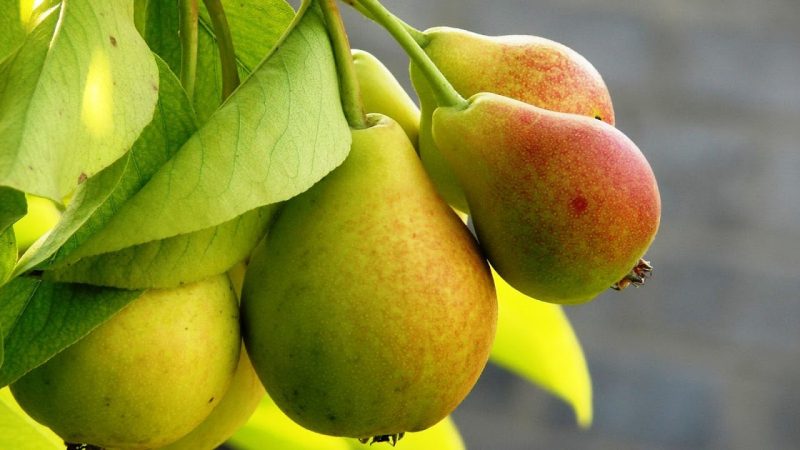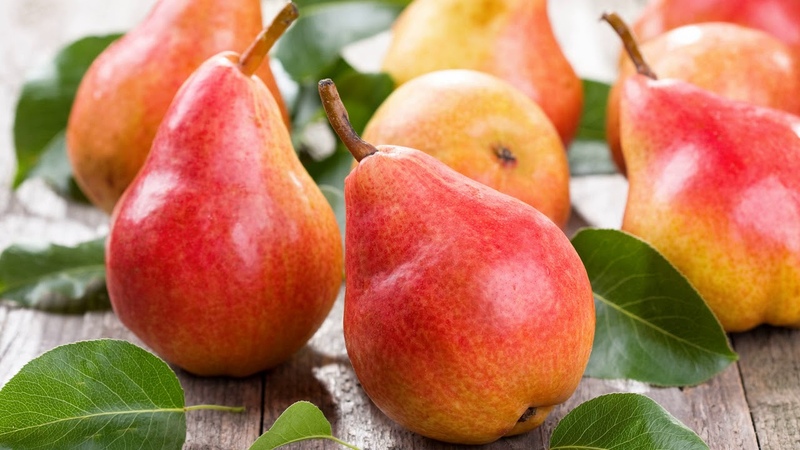A selection of the best varieties of the most delicious winter-hardy pears for Siberia
Garden pear fruits are tasty, juicy, and have many beneficial properties for the body. The tree has a high yield, is unpretentious in maintenance and grows practically throughout the entire territory of our country. If your garden plot is located in Siberia, learn more about planting and caring for zoned varieties of winter-hardy pears in our article.
The content of the article
Requirements for pear varieties for Siberia
The main requirement for Altai and Siberian pears is winter hardiness. The harsh climate will easily destroy any frost-resistant varieties, therefore, the choice of culture should be approached very carefully.
Advantages and disadvantages of winter-hardy pears

Because the cold climate slows down the growth of trees, all taiga pears are short.... This allows the summer resident to harvest the crop without the use of special equipment - just a ladder and a bucket are enough. The crown of the trees is spreading, which ensures hassle-free care.
Fruit weight is average, suitable for curling and preservation. Low shedding of fruits - even with severe frosts and winds, 90% of the crop will remain on the branches. The disadvantages include a decrease in the mass of fruits every year.
The winter-hardy plant has a hungry need for fertilizers and minerals, which is difficult to replenish in Siberia. Also, pears are very susceptible to various diseases here, their bark becomes thinner from the winds and cold and becomes a tasty morsel for pests. These pears need regular watering and careful maintenance.
Characteristics and description of the best winter-hardy representatives
In Siberia, only hybrid pear species adapted to cold conditions are grown in the open field. Below we will give a description of the most delicious and winter-hardy pear varieties for Siberia.
Dekabrinka
Dekabrinka is characterized by medium growth vigor. The height of the tree does not exceed 5 m, it begins to bear fruit at the age of 7. The crown of the tree is dense and round, the leaves are small, smooth and shiny, the branches stretch downward. Adult shoots are medium in size, lanceolate stipules.
Flowering occurs late, which protects the pear from late spring frosts. The variety is characterized by regular fruiting. The fruits are ovoid, yellow or dark yellow in color with a slight blush, the flesh is white, moderately dense. Not capable of self-pollination. Late-flowering varieties are chosen for pollination, for example, Uralochka. This pear variety is suitable for the Altai region.
Autumn dream
This is a technical pear, well suited for production and sale. The tree is not tall, does not exceed 4.5 m, the crown is pyramidal. The variety is resistant to frost and slightly susceptible to diseases, it is one of the problem-free pears for growing in Siberia. It blooms and bears fruit for 7 years, closer to autumn.
The fruits are densely located on the branches, but small - 60-80 g. The main color is yellow-brown with pronounced subcutaneous punctures. The consistency of the fruit is granular, sourish in taste. The main drawback is the unpresentable appearance.
Severyanka
In the Urals, Severyanka takes root well. Medium-sized tree with high growth rates. The crown is rounded, branches are strong and thick, wide shoots, leaves are dense, rounded, with jagged edges, dark green in color.The peduncles are long, straight and curved.
Severyanka begins to bear fruit in early summer. Its fruits are spherical, or slightly elongated, of uneven size - from 60 to 120 g. During ripening, their color ranges from green to green-yellow. Overripe fruits have a red or pink blush, so sometimes this pear is called red-cheeked.
There are few seeds, but they are large. The pulp of the pear is beige, impatient, wine-sweet. Severyanka is the leader in yield. The first fruits are harvested as early as 3 years after planting. The main disadvantages include the small size of most fruits and drought tolerance.
Perun
Perun is a tree 3-4 m high with a wide spreading crown. It begins to bloom in August, hence the late fruiting dates - pears are harvested from October until the first frost. Begins to bear fruit 4-5 years after planting in open ground.
Fruits are large, irregular ovoid, golden and red-golden in color. Fruit taste is juicy, sweet, does not lose its properties for a long time. Well suited for preservation, drying. The main advantage of the variety is resistance to the most common fungal diseases. The disadvantages include low winter hardiness.
Svarog
Svarog, together with Perun, is considered one of the best sweet pear varieties for Siberia. Svarog is a low pear with a spreading crown. Average yield, falls on the 4th year, ripening - in mid-September. The fruits are kept at home for up to 3 weeks in a cool place and up to several months in the refrigerator. The pears themselves are bright green, dense, sweet and sour.
The pear tolerates frost perfectly, which is why it is so loved by the inhabitants of Siberia. The main disadvantage is heavy maintenance of the tree, which is seasonally attacked by the pear moth.
Lel
Lel grows up to 6 m in height, actively bears fruit throughout the summer-autumn season, therefore it is in great demand among gardeners. Productivity is high, usually fruits appear 5 years after planting.
Lel has an elongated oval shape of yellow color with a red barrel. The pulp is white, sweet, spicy. It is best to start planting Lel in late spring. Buy seedlings immediately before planting, they are poorly stored. Lel is a capricious variety, loves moist loamy soil.
Uralochka
Altai gave us for cultivation such a pear as Uralochka - the most winter-hardy variety in the Ural region. The tree reaches 4-5 m, branches are of medium thickness, directed upwards.
Uralochka has small, rounded, pale yellow fruits, the surface of which is covered with gray subcutaneous dots, slightly rough to the touch. The flavor ranges from sweet to sweet and sour. The tree bears fruit for 4 years in late autumn. It is unpretentious in care, has a high immunity to pests, and is easily transported.
Fabulous
The pear belongs to the trees with a high growth rate, reaching 8 m in height. The crown of the tree is narrow-pyramidal, rarely spreading. Flowering occurs in late May - early June. Fruits are medium in size, pear-shaped. When removed, they have a uniform yellow-green color, there is no blush. The pulp is loose, creamy, medium-grained.
The fruits almost do not crumble and hang on the branches for a long time. The tree is self-fertile, the best pollinator is Severyanka. The crop grows evenly 2 years after planting.
Carmen
Carmen is a table pear with bright red oval fruits of the correct shape. Carmen grows into a tree up to 5 m with a wide spreading crown. When ripe, the fruits darken and reach a brownish-red hue. They are juicy, sweet, without a hint of astringency.
Carmen is a summer variety, ripening in the second half of July. It is easily planted by cuttings, has high immunity, but low frost resistance. Carmen has an average yield, but it is a long-lived pear: with proper care, its life reaches 50 years.
Pear Chizhovskaya
A medium-sized tree with a narrow crown. Shoots are also of medium length and thickness, rounded in cross section.Fruits are yellow-green in color with a regular pear-shaped shape. They have a pronounced sweet and sour taste. The variety is frost-resistant, unpretentious, easy to care for. But over time, the fruits become smaller, become more sour.
Lukashovka
Medium height tree with high yield. Bears fruit in a year. Fruits take on a variety of shapes from round to cubic. Unripe fruits have a specific sour taste, those that have reached maturity are sweet, but not stored for a long time and quickly deteriorate.
According to gardeners, this variety shows itself well when preserved, well suited for jam and compotes. Lukashovka loves dry places, ideally sandy soil. A pear cannot self-pollinate, so it needs pollination from a nearby tree.
How to choose a variety

Pears are divided into varieties depending on the ripening period. Choose a tree based on what time it is convenient for you to plant a pear and when you plan to harvest:
- Early variety - planted in the ground in spring, in April - early May. Fruits are harvested in the summer, in July - August.
- Middle - planted in late spring. Fruiting in the autumn-summer period - late August - early October.
- Late - planted at the end of May. The fruits appear in early September, but they are not harvested until October. These pears are left to ripen in a cool place.
Features of planting and care of winter-hardy varieties of pears in Siberia
The problem of growing pears in Siberia is not solved only by acquiring frost-resistant and early ripening varieties - planting, care, and the right choice of seedlings also play an important role: pick a two-year-old for a frosty region. He will take root much better than a very young one.
The bark on the seedling should be smooth and even, and the trunk should be no more than 80 cm. Plant the tree in sunny times, regardless of the season. Pear is a sun-loving plant, but it can be planted in spring, summer and autumn.
Landing space
Choose a dry and level area of black soil, protect the pear as much as possible from root decay, do not plant in swampy areas or in soil with active groundwater. It is preferable to plant a tree near a fence or other support, so you protect the plant from the wind.
Landing scheme
Dig a hole twice the size of the root system of the seedling, fill it with two buckets of humus or compost, lower the seedling and cover with earth, trying to avoid air pockets. Place supports on both sides of the seedling and secure it with fine nylon thread. Compact the soil and pour two buckets of water on top.
If there are several seedlings, place them at a distance of 1.5-2 m from each other.
Pear care in Siberia

A young tree is watered immediately after planting at least 2 times a week. Pour at least 5-6 buckets of lukewarm water... It is enough to water an adult tree once a week with 25-30 buckets of water. The soil must be loosened and mulched.
If the summer is hot, the tree is sprayed over the crown. Before frost, the trunk is whitewashed and wrapped with spruce branches, reeds or thick paper, the snow is collected around the pear in a large snowdrift, covering it.
They start pruning in the very first year of the pear's life, form a uniform, well-translucent crown. If desired, make feeding and fertilizers.
It is interesting:
How to properly plant cherries in the fall.
How to properly cover an apricot for the winter and prepare a tree for cold weather.
What peach care is needed in the fall to prepare for the cold.
Conclusion
The Siberian region is distinguished by a sharply continental climate with frosty winters. When choosing a pear for your garden, focus not only on taste, but also on growth characteristics. Growing a dwarf tree with a columnar crown will be problematic, as well as an untimely variety.
Trees with stable immunity, winter-hardy, early ripening, self-pollinating are ideal options. Do not forget about insulation, protection of the pear and careful monitoring of the condition of the soil - it should be moderately moist, but not wet.